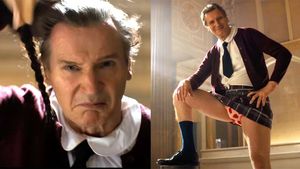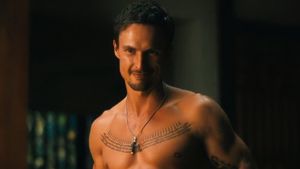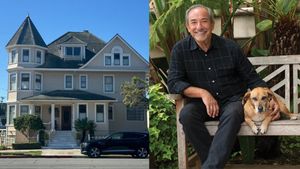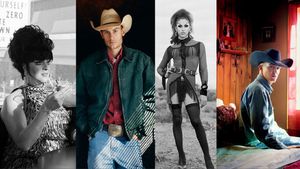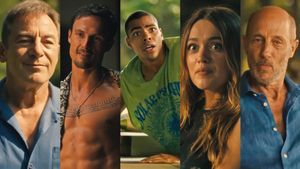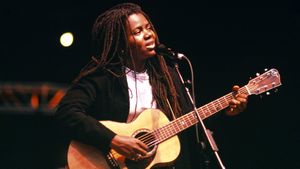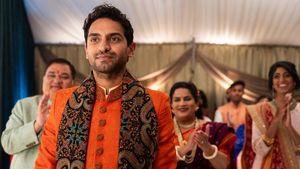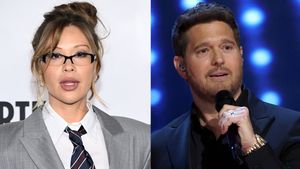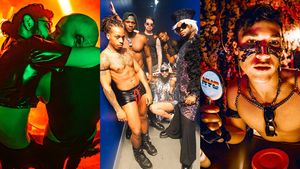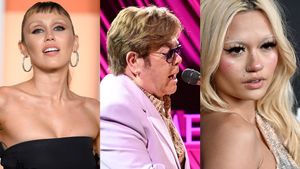When Tom
Kalin's Swoon premiered at Sundance in
1992, it was part of a collection of daring films that
heralded the birth of New Queer Cinema. Gay movies
have gotten steadily more mainstream since then, but
Kalin has largely stayed out of the fray, choosing
instead to make short films and teach film at Columbia
University. This year he returns to Park City with Savage
Grace, a film chronicling the scandalous true
story of socialite Barbara Baekeland (Julianne Moore), whose
incestuous affair with her gay son Tony (Eddie Redmayne)
ended in murder.
Sundance helped launch New Queer Cinema in 1992,
and this year many of the movement's
filmmakers are returning. You've got
your first film since Swoon, Gregg Araki is
back with a restored print of The Living
End, even Derek Jarman, who was there with Edward
II, is represented via Isaac Julien's
Jarman documentary. What's going on? Is it
just kismet, or is this a queer renaissance?
Who knows? You
know, we premiered at Cannes at May and I've done a
fair amount of press where people been asking,
"What happened to New Queer Cinema? Does it
exist? What did it mean?" I don't know. I
think what's interesting is, What is queer
cinema now? Does it have to be a queer movie? Does the
director have to be gay or lesbian for the movie to be
queer? Is it about the content of the film or the audience
perception?
I think different
people's work involves it in different ways, like
Isaac's work or Gregg's or Todd
Haynes's. Some of their work has been
gay-themed, and some of it hasn't been. My two
features as director have had gay content, but
there's a whole body of work I've done,
including shorts, where some of it's been gay
and some of it hasn't been. I don't know
if it's serendipity or if things have come around
full circle. Or maybe we're older and wiser and
we're ready for a reunion. [Laughs]
Tell me a little bit around the real-life story
that inspired this film. What was it that attracted you
to it?
There's a
nonfiction book that came out in the '80s called
Savage Grace, which is actually going to be
rereleased later in the year to tie into the movie.
It's written by Steven Aronson and Natalie
Robins, and it's this amazing book -- primarily
an oral history, so it's a series of interviews from
people who knew the characters -- and there are
excerpts of things like letters from Barbara to Tony.
In condensing the movie, you always take liberties. You
condense characters, you compress time frames, you deal with
issues of chronology. Still, this story is the same
kind of thing I remember from the book, that sort of
shocking thing you read by the swimming pool and
you're just like, "Oh, my God, I can't
believe it!" But in a deeper way, what makes
this great tragedy is that this impact between a mother and
a son is an ancient theme. That's what
attracted me to it: It combines something that was
sensational and shocking with something that had much
deeper emotions to it.
What sort of emotions?
It's
really a portrait of a family that has so much privilege
that they're not responsible in the same ways
-- particularly at that period of time, before
everyone talked about a culture of sexual abuse or were
even aware of such a thing. I think that's the real
tragedy of Barbara and Tony -- they kind of went out
on this limb in broad daylight, but because of the
social circle they were in, there weren't real
repercussions. There's a scene where Tony talks about
how one of the things of having money is that it
allows you not to live out the consequences of your
mistakes. It's true, in a way. Having privilege
allowed them to live easy lives, but it also allowed them to
indulge in the self-destructive, emotionally
unbalanced dynamics between them.
I understand that the photos in the book also
informed your film in a particular way?
They were a big
influence in the look, the character, but also the
psychology. There's this amazing picture of Tony in
the bathtub at age 11 or 12, clearly taken by Barbara,
totally naked, completely comfortable being
photographed. I don't know about you, but I
wouldn't have liked being photographed naked at
11 years old by my mother! All those photographs hint
at something that's going on underneath the surface.
How did the story come to you?
I think
[producer] Christine Vachon and I have had a kind of
unhealthy fascination with true-crime books for years.
I've known Christine now for about 20 years,
and when were first getting to know each other, one of
the ways we would become friends is we would exchange these
shocking paperbacks that always had photos in the
middle of them. It was like, "Oh, my God, can
you believe that crime? It's horrible!"
[Laughs] This one she gave me around 1991 and
said, "I think you're really suited to
this." The writing of the book is of a different
caliber--it's not known as a true-crime
book, it's a piece of journalism. I was also
influenced hugely by books like In Cold Blood
and the idea of Capote's approach to combining the
best of fictional storytelling with the kind of
vibration you get from something that really happened.
How does sexuality enter into it?
I'm
particularly interested in the role of sexual identity in
historical period. In this case, it's just past
Stonewall when the murder happens. It's
interesting, because everyone thinks that Tony is gay,
although nominally bisexual at least for a while. He
sleeps with Barbara and he's attracted to her
in some ways, even though he's more gay than
straight. What I think really works in the film, though, is,
Is he the killer? Or does Barbara use her son as a
tool to commit suicide? Yes, Tony uses a knife and
kills her, but she's provoked him and emotionally
manipulated him because she's such a narcissistic
character. I don't know if you can call that
relationship fully consensual. He's damaged.
I don't
think Barbara intentionally did this -- I don't think
she said, "I'm going to sleep with my
son until he kills me." But I think that was
part of the equation, part of the dance between the two of
them. It's interesting, because a friend of
mine saw the film who's been an AIDS activist
for many years, he was in ACT UP in the '80s, and he
said, "It's really a story about the
setting free of the son. You can see this film about
the son killing the mother, but it's also about this
terrible thing happening between two people that
releases Tony." And although what happens to
him is not optimistic, there's something to that.
There's two people in this fatal dance
together, and the only way out is to go all the way
until Barbara gets what she wanted -- which is to escape
this world and die -- and Tony's free of the
burden of his mother.
Have you been working on other features in between
Swoon and Savage Grace or even now?
Actually, right
now I'm working on a romantic story -- there's
no murder, there's no perverted sexuality in
it! [Laughing] In the interim between
Swoon and Savage Grace, I tried to do a
biography about Patti Smith and Robert Mapplethorpe
that, for complicated reasons, didn't come
together. I'm definitely interested in the idea of
nonfiction-based films and trying to bring something
fresh to that genre.
What kind of reaction have you gotten to Savage
Grace so far?
It's been
an interesting ride, this movie. After the scene of incest
between Barbara and Tony, the audience tends to be
absolutely silent when the credits first come up, and
at first I was like, "Oh, my God, I've
failed completely!" But then at Cannes, the audience
leapt to its feet and we got a standing ovation, and
you realize, "It's just a tough
movie." I knew it would be a tough movie; I knew it
would be hard to shoot that incest scene.
That's the difference between Swoon and
Savage Grace. I'm an older person
now, and doing that sort of thing is emotionally
difficult in terms of what you're asking the actors
to do. When we were shooting the murder scene, some of
what is horrific on screen wasn't really that
awful, but shooting the incest scene was awful.
Both of your feature films are about gay killers --
not necessarily the most PC theme.
You know,
Swoon in some complicated way comes out of
AIDS. That rage, that despair -- the movie is definitely not
an allegory about AIDS in any way, but it's a
movie of that particular time. It's about my
own relationship with AIDS activism and people with HIV and
AIDS in my life who died and how bewildering that was at my
age. This film isn't as connected to a certain
time in my life in that way. I've never wanted
to be seen as a spokesperson, I just don't. I
appreciate the support I've gotten from the gay
and lesbian community as a filmmaker, but I just
don't think of my films as identity-based in that
kind of way. In other words, I'm not making a
film that's trying to talk about all gay
people. In my personal life I have a 15-year-long
relationship that's happy and well-adjusted.
I'm not a tortured soul at all, really.


